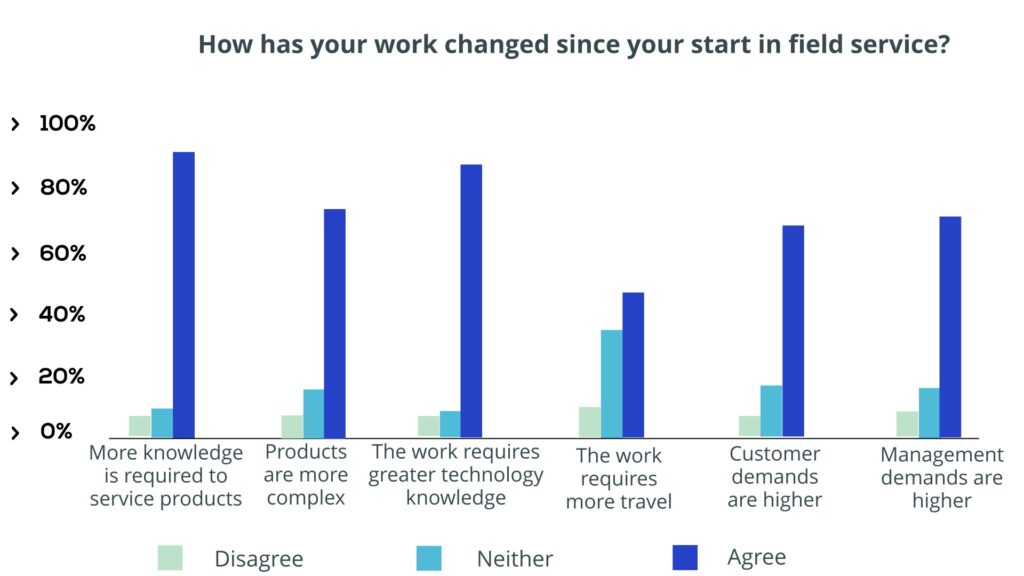Field Service 2021: The Demand For A Single Source Of Truth
Every year The Service Council issues the results of their “Voice of the Field Service Engineer” survey, yielded from hundreds of participants on the front lines of field service.
The 2021 survey results were particularly interesting because, when asked how their work has changed since they started in field service, over 90% of survey respondents said that more knowledge is required to service modern products.
Additionally, nearly 70% of respondents said products are more complex today, while over 80% said that their current field service responsibilities require “greater technology knowledge”, compared to when they first started.

Demand for a Single Source of Truth
The fine work by the Service Council highlights what many service leaders already know – your field service staff are in desperate need of a “Single Source of Truth”. A Single Source of Truth would provide them with the relevant and up-to-date information needed on site, such as installation and servicing documents, product and safety notices, FAQs, parts lists and exploded diagrams. In many companies, technical product documentation, parts lists and exploded product diagrams are unintentionally locked up in corporate silos or disparate file formats.
The Need for Knowledge Has Never Been More Important
Finding servicing information is so difficult and time consuming, that many field service engineers defer to “winging it” or calling a buddy. Neither of these solutions is acceptable when efficiency, accuracy and customer satisfaction is on the line.
Even if the documentation is available on an internal network, expecting a field engineer to download and cull through a 200-page PDF to find the answer to one question is not reasonable or efficient.
Delivering current documentation and accurate parts lists sounds like basic blocking and tackling, but it’s not. Field service leaders need to come to grips with the fact that their new Millennial field service technicians’ primary computing device is a mobile phone and not a laptop. Trying to convince them otherwise will be a futile battle.
After you cry uncle on the mobile phone versus laptop controversy, it will be time to figure out how to keep technical documentation and parts lists current and available. Field service leaders will attest that installation and servicing documentation and parts lists designed to be used by field service engineers are often out-of-date. Providing inaccurate documentation and parts information is a sure-fire way to make a field service engineer clench their teeth in frustration.
Establishing a Single Source of Truth is not for the Faint of Heart
The fact is that creating, maintaining and distributing up-to-date technical documentation and parts information is a mundane and costly task that few field service organizations do well.
This rise in complex products has resulted in complex service and maintenance procedures, affecting and influencing inaccuracies in technical writing and documentation. Companies still rely on traditional time-intensive methods to develop and deploy technical documentation such as service procedures, work instructions, guides, manuals, etc. As the demand for complex maintenance and service procedures increase, technician efficiency decreases due to more time being spent searching for the correct service information in a format that can be used on the field.
Poor Access to Information Leads to Wasted Time
When service technicians encounter unfamiliar problems and don’t have reliable service information to solve a problem, the need for costly telephone calls back into technical support and repeat service visits increases. Poor access to servicing documentation and parts information is a serious time waster.
For example, one of our AnswersAnywhere customers has 500 field service engineers making 3 service calls per day. Based on surveys, the service leaders estimated that each engineer spends an average of 30 minutes per service call finding servicing documentation and parts information.
By providing their field staff with a mobile Single Source of Truth, each engineer saved 15 minutes in research time per service call. Over the course of a year, the 500 field service engineers combined saved a total of 99,000 hours of research time.
That’s 99,000 hours that can be repurposed into improving customer satisfaction, educating customers on new products or increasing service calls.
Bottom Line: It Doesn’t Have to be Difficult
Most companies have a wealth of technical knowledge and parts information that – when put into the hands of the field service staff – would increase customer satisfaction and decrease wasted time.
Creating and managing a Single Source of Truth for field service engineers is the perfect outsourcing opportunity because you can avoid technology evaluations, process development projects or hiring staff to keep everything updated.



